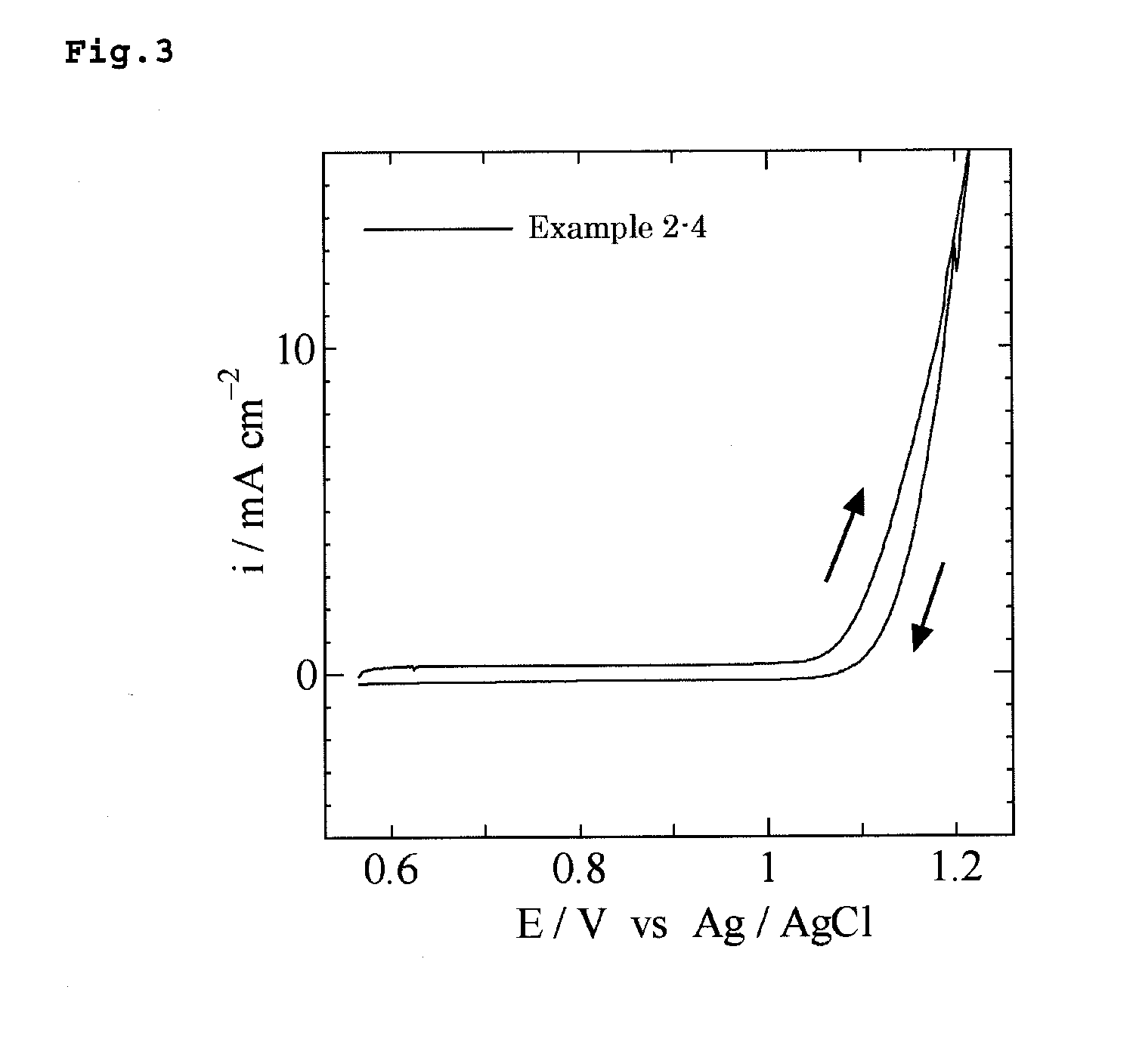Anode for use in zinc and cobalt electrowinning and electrowinning method
an anode and cobalt technology, applied in the direction of electrical-based machining electrodes, instruments, manufacturing tools, etc., can solve the problems of reducing the purity of cobalt deposited on the cathode by the anode, high electric energy consumption is required for the anode reaction, etc., to reduce the electrolysis cost and zinc production cost, reduce the electric energy consumption, and reduce the effect of electric energy consumption
- Summary
- Abstract
- Description
- Claims
- Application Information
AI Technical Summary
Benefits of technology
Problems solved by technology
Method used
Image
Examples
example 1-1
[0075]A commercially available titanium plate (5 cm long, 1 cm wide, 1 mm thick) was dipped and etched in a 10% oxalic acid solution at 90° C. for 60 minutes, and then washed with water and dried. An application liquid was prepared such that the mole ratio of hydrogen hexachloroiridate hexahydrate (H2IrCl6.6H2O) to tantalum chloride (TaCl5) in a butanol (n-C4H9OH) solution containing 6 vol. % concentrated hydrochloric acid was 80:20 and a total amount of iridium and tantalum was 70 mg / mL in terms of metal. The application liquid was applied to the titanium plate and then dried at 120° C. for 10 minutes before thermal decomposition for 20 minutes in an electric furnace maintained at 360° C. The application, drying and calcination was repeated five times, thereby producing an electrode having a catalytic layer formed on the titanium plate. The electrode was structurally analyzed by X-ray diffractometry, resulting in an X-ray diffraction image with no diffraction peak profile correspon...
example 1-2
[0076]An electrode was produced in the same manner as the electrode production method of Example 1-1, except that the thermal decomposition temperature was changed from 360° C. to 380° C. The obtained electrode was structurally analyzed by X-ray diffractometry, the result being that a diffraction line corresponding to IrO2 had a broadened pattern with overlapping small peaks and no diffraction peak profile corresponding to Ta2O5 was recognized, so that the catalytic layer was confirmed to be formed of amorphous iridium oxide, crystalline iridium oxide, and amorphous tantalum oxide. Next, constant-current electrolysis was performed with the method and conditions shown in Example 1-1. A change in weight of the anode before and after the electrolysis revealed that a manganese compound of 2.3 mg / cm2 was deposited by the electrolysis.
example 2-1
[0079]A commercially available titanium plate (5 cm long, 1 cm wide, 1 mm thick) was dipped and etched in a 10% oxalic acid solution at 90° C. for 60 minutes, and then washed with water and dried. An application liquid was prepared such that the mole ratio of hydrogen hexachloroiridate hexahydrate (H2IrCl6.6H2O) to tantalum pentachloride (TaCl5) in a butanol (n-C4H9OH) solution containing 6 vol. % concentrated hydrochloric acid was 80:20 and a total amount of iridium and tantalum was 70 mg / mL in terms of metal. The application liquid was applied to the titanium plate and then dried at 120° C. for 10 minutes before thermal decomposition for 20 minutes in an electric furnace maintained at 360° C. The application, drying and calcination was repeated five times, thereby producing an electrode having a catalytic layer formed on the titanium plate. The electrode was structurally analyzed by X-ray diffractometry, resulting in an X-ray diffraction image with no diffraction peak profile corr...
PUM
| Property | Measurement | Unit |
|---|---|---|
| temperature | aaaaa | aaaaa |
| temperature | aaaaa | aaaaa |
| temperature | aaaaa | aaaaa |
Abstract
Description
Claims
Application Information
 Login to View More
Login to View More - R&D
- Intellectual Property
- Life Sciences
- Materials
- Tech Scout
- Unparalleled Data Quality
- Higher Quality Content
- 60% Fewer Hallucinations
Browse by: Latest US Patents, China's latest patents, Technical Efficacy Thesaurus, Application Domain, Technology Topic, Popular Technical Reports.
© 2025 PatSnap. All rights reserved.Legal|Privacy policy|Modern Slavery Act Transparency Statement|Sitemap|About US| Contact US: help@patsnap.com


